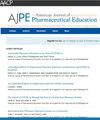Student Identification of Medically Underserved Populations During a First-Year Community Introductory Pharmacy Practice Experience
IF 3.5
4区 教育学
Q1 EDUCATION, SCIENTIFIC DISCIPLINES
引用次数: 0
Abstract
Objective
This evaluation determined the ability of first-year (P1) students to recognize medically underserved populations after completing a required community Introductory Pharmacy Practice Experience (IPPE).
Methods
Students completed a 40-h community IPPE and submitted post‐experience reflections. Reflection prompts included patient populations they interacted with or observed, and impactful patient interactions or discussions with their preceptors related to medically underserved populations. Content analysis was performed to analyze student reflections.
Results
All 192 first-year pharmacy students completed postrotation reflections; 72.9% (n = 140) accurately identified a medically underserved population. Low-income (37.5%), rural (13%), individuals with limited English proficiency (10.4%), and individuals with disabilities (9.4%) were most frequently identified. Two additional themes emerged from the student reflections: (1) barriers to care and (2) the role of the pharmacist in supporting medically underserved patients. Students (n = 95) listed at least 1 barrier to care (106 instances), with 5 subthemes: low socioeconomic status, limited English proficiency, rurality, disability, and low health literacy. Students (n = 93) also listed at least 1 pharmacist role (130 instances) with 4 subthemes: increasing access to health care, patient advocacy, improving knowledge of medication use, and administering vaccinations.
Conclusion
Most P1 students on their community IPPE identified a medically underserved population, described barriers to care, and listed ways pharmacists can mitigate these barriers. By engaging in this activity with authentic practice-based exposure early in the curriculum, students may be able to perform abstract conceptualization and make connections from classroom to practice to better care for medically underserved populations in the future.
在第一年的社区药学入门实践经验中,学生对医疗服务不足人群的识别。
目的:这项评估确定了一年级(P1)学生在完成必需的社区药学入门实践经验(IPPE)后识别医疗服务不足人群的能力。方法:学生完成40小时的社区IPPE并提交经验后反思。反思提示包括与他们互动或观察的患者群体,以及与医疗服务不足人群相关的有影响力的患者互动或与其导师的讨论。进行内容分析,分析学生反思。结果:192名P1学生均完成轮转后反思;72.9% (n=140)能够准确识别医疗服务不足的人群。低收入(37.5%)、农村(13%)、英语水平有限(10.4%)和残疾人(9.4%)是最常见的人群。从学生的反思中产生了另外两个主题:1)护理的障碍,2)药剂师在支持医疗服务不足的病人方面的作用。学生(n=95)列出了至少一个护理障碍(106例),其中有5个子主题:低社会经济地位、英语水平有限、农村、残疾和低健康素养。学生(n=93)还列出了至少一种药剂师角色(130例),其中有4个子主题:增加获得医疗保健的机会、患者宣传、提高药物使用知识和管理疫苗接种。结论:大多数P1学生在他们的社区IPPE中确定了医疗服务不足的人群,描述了护理障碍,并列出了药剂师可以减轻这些障碍的方法。通过在课程的早期进行这种以真实实践为基础的活动,它可以让学生进行抽象的概念化,并将课堂与实践联系起来,以便将来更好地照顾医疗上得不到服务的人群。
本文章由计算机程序翻译,如有差异,请以英文原文为准。
求助全文
约1分钟内获得全文
求助全文
来源期刊
CiteScore
4.30
自引率
15.20%
发文量
114
期刊介绍:
The Journal accepts unsolicited manuscripts that have not been published and are not under consideration for publication elsewhere. The Journal only considers material related to pharmaceutical education for publication. Authors must prepare manuscripts to conform to the Journal style (Author Instructions). All manuscripts are subject to peer review and approval by the editor prior to acceptance for publication. Reviewers are assigned by the editor with the advice of the editorial board as needed. Manuscripts are submitted and processed online (Submit a Manuscript) using Editorial Manager, an online manuscript tracking system that facilitates communication between the editorial office, editor, associate editors, reviewers, and authors.
After a manuscript is accepted, it is scheduled for publication in an upcoming issue of the Journal. All manuscripts are formatted and copyedited, and returned to the author for review and approval of the changes. Approximately 2 weeks prior to publication, the author receives an electronic proof of the article for final review and approval. Authors are not assessed page charges for publication.

 求助内容:
求助内容: 应助结果提醒方式:
应助结果提醒方式:


